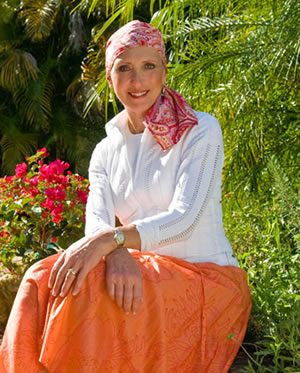Positive Health Online
Your Country

Remove bookmark
Case Study: Three Generations of Breast Cancer Survivors
listed in cancer, originally published in issue 167 - February 2010
Susan Beausang's family is not your typical family. Susan comes from a 3-generation family of women who have struggled with breast cancer, including her grandmother, her mother, her maternal aunt and two of her sisters. Susan and three of her sisters (and brother) have struggled with the threat of breast cancer – they were all carriers of the BRCA2 gene. Susan had a lot to be concerned about.

Susan M. Beausang
While playing at their summer house on the Jersey shore, Susan, as young girl, would watch her grandmother outside in a sundress and knew that something was not right. The left side of her grandmother's upper body wasn't like other women. Susan didn't know then that her grandmother had had a super radical mastectomy – an aggressive treatment used in the 1950s to treat breast cancer. This procedure not only removed the breast tissue, the lymph nodes, and the chest wall muscles, but also part of the rib cage. This left a woman having this treatment quite disfigured.
Susan's maternal aunt, only in her 30s, was diagnosed with breast cancer shortly after her grandmother was diagnosed. She underwent the same radical procedure resulting in the same disfiguration; reconstruction was not an option in those days. Despite their surgery, both women had recurrences and eventually died from the disease. During the 50s and 60s, the radical mastectomy and the super radical mastectomy were the common treatments used when a woman was diagnosed.

Paula Poons (Cancer Survivor – BRCA 2 carrier), Judy Zuccone (BRCA2 carrier),
Mary Toebbin (2 time cancer survivor BRCA2 carrier), Susan Beausang (BRCA2 carrier)
Things began to change when cancers were detected earlier in their development. The 70s became a time of great transition, combining the options of the modified radical mastectomy, breast removal, sometimes lumpectomies, and even the beginning of chemotherapy, but the doctors were still primarily in control of the decision-making when it came to determining the course of treatment.
The 80s still held onto the ideas of the 70s, but also saw a movement towards more lumpectomies combined with radiation, and a movement towards women having some say in the decisions regarding their course of treatment. Susan's mother was diagnosed with breast cancer in the mid-80s, and had a modified radical mastectomy without reconstruction.

Paula Poons (cancer survivor), Susan Beausang
In 1991, Susan's sister was diagnosed at the young age of 29. With many more options available to women and the movement towards women being directly involved in the course of their treatment, given her family history, she had one of her breasts removed. Eight years later, she had a recurrence and the other breast was removed. In 1999, Susan's other sister was diagnosed with breast cancer and, signifying the radical changes from the 50s through the 90s, she elected to have both breasts removed and undergo chemotherapy, even though her doctor recommended a lumpectomy. This seemed to her a logical choice considering her family history. When her pathology came back, it was determined that she had cancer in both breasts in spite of the other breast appearing normal in a mammography. Her advocacy may have saved her life.
This brings us to the host of options available to women today – including being able to be tested in advance of any diagnosis. Because of their history, Susan's family entered a study at the University of Pennsylvania Hospital testing for genetic mutations. It was determined that they were BRCA2 carriers – a gene that places women as high risk for developing breast and other types of cancer.
Out of 8 siblings, 7 were tested and 5 tested positive for the gene mutation – 4 girls and 1 boy. Susan and her older sister, who tested positive for the BRCA2 gene, but had not developed cancer, both elected to have a prophylactic mastectomy and oophorectomy (removal of the ovaries).
It is truly amazing to see how far we've come over the last 50 years in the diagnosis, the treatment, and the respect for the needs of women to make their own decisions regarding their bodies. Susan's grandmother and aunt had no choice in the course of their treatment. The doctor said, "You have a lump. We are going to perform surgery. Sign this paper. When you awaken, you will know whether or not I decided to remove your breast and, if so, anything else that I felt was necessary." This new generation has taken a proactive role in gathering their own knowledge and deciding for themselves the course of action that feels right to them – even a seemingly radical decision to remove healthy breast tissue in order to prevent this disease – an idea not remotely considered 50 years ago.
Ironically, after being so pro-active regarding her health as it pertained to the threat of breast cancer, Alopecia entered Susan's life. Conditioned to believe that she may be susceptible to breast cancer and thus may lose her hair – and feeling that she had done everything that she could to avoid that, she certainly didn't expect to lose her hair to something other than cancer treatment. Alopecia is a disease that attacks the body's hair follicles – resulting in, in Susan's case, permanent and complete hair loss.
In a bizarre twist of fate, Susan has found her life's calling. She has turned her own circumstances, and that of her family, into an international business that provides alternatives for the very women that she has known and struggled alongside all of her life. She now designs headscarves for women undergoing medically-induced hair loss and has come to find comfort and success in helping the women that she can relate to on so many levels.
Susan's business can be found at www.4women.com
Comments:
-
No Article Comments available